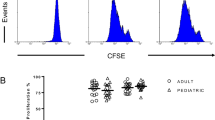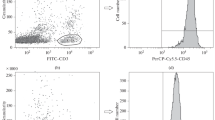Abstract
Blood samples were obtained from 10 male autistic children ages 7–15 years and 10 age-matched, male, healthy controls. Lymphocyte subsets (helper-inducer, suppressor-cytotoxic, total T, and total B cells) were enumerated using monoclonal antibodies and flow cytometry. Bound and soluble interleukin-2 receptors were assayed in unstimulated blood samples and in cell cultures following 72-hour stimulation with phytohemagglutinin. The children with autism had a lower percentage of helper-inducer cells and a lower helpersuppressor ratio, with both measures inversely related to the severity of autistic symptoms (r=−.56 and −.68, respectively). A lower percentage of lymphocytes expressing bound interleukin-2 receptors following mitogenic stimulation was also noted, and this too was inversely related to the seventy of autistic symptoms.
Similar content being viewed by others
References
Ganguli, R., & Rabin, B. S. (1989). Increased serum interleukin 2 receptor concentrations in schizophrenic and brain-damaged subjects.Archives of General Psychiatry, 46, 292.
Krug, D. A., Arick, J., & Almond, P. (1980). Behavior checklist for identifying severely handicapped individuals with high levels of autistic behaviors.Journal of Child Psychology and Psychiatry, 21, 221–229.
Maes, M., Bosmans, E., Suy, E., Vandervorst, C., Dejonckheere, C., & Raus, J. (1991). Antiphospholipid, antinuclear, Epstein-Barr and cytomegalovirus antibodies and soluble interleukin-2 receptors in depressive patients.Journal of Affective Disorders, 21, 133–140.
Rapaport, M. H., McAllister, C. G., Pickar, D., Nelson, D. L., & Paul, S. M. (1989). Elevated levels of soluble interleukin-2 receptors in schizophrenia.Archives of General Psychiatry, 46, 291–292.
Ritvo, E. R., Yuwiler, A., Geller, E., Ornitz, E. M., Saeger, K., & Plotkin, S. (1970). Increased blood serotonin and platelets in early infantile autism.Archives of General Psychiatry, 23, 566–572.
Singh, V. K., Warren, R. P., Odell, J. D., & Cole, P. (1991). Changes of soluble interleukin-2, interleukin-2 receptor, T8 antigen, and interleukin-1 in the serum of autistic children.Clinical Immunology and Immunopathology, 61, 448–455.
Slauson, D. O., Walker, C., Kristensen, F., Wang, Y., & DeWeck, A. L. (1984). Mechanisms of serotonin-induced lymphocyte proliferation inhibition.Cellular Immunology, 84, 240–252.
Smith, K. A. (1988). Interleukin-2: Inception, impact, and implications.Science, 240, 1126–1146.
Stubbs, E. G., Crawford, M. L., Burger, D. R., & Vandenbark, A. A. (1977). Depressed lymphocyte responsiveness in autistic children.Journal of Autism and Childhood Schizophrenia, 7, 49–55.
Wadden, N. P., Bryson, S. E., & Rodger, R. S. (1991). A closer look at the Autism Behavior Checklist: discriminant validity and factor structure.Journal of Autism and Developmental Disorders, 21, 529–541.
Warren, R. P., Foster, A., & Margaretten, N. C. (1987). Reduced natural killer cell activity in autism.Journal of the American Academy of Child and Adolescent Psychiatry, 26, 333–335.
Warren, R. P., Foster, A., Margaretten, N. V., & Pace, N. C. (1986). Immune abnormalities in patients with autism.Journal of Autism and Developmental Disorders, 16, 189–197.
Warren, R. P., Yonk, L. J., Burger, R. A., Cole, P., Odell, J. D., Warren, W. L., White, R., & Singh, V. K. (1990). Deficiency of suppressor-inducer (CD4+D45RA+) T cells in autism.Immunological Investigations, 19, 245–251.
Wright, H. H., Abramson, R. K., Self, S., Genco, P., & Cuccaro, M. L. (1990).Serotonin may affect lymphocyte cell surface markers in autistic probands. Presented at the Annual Meeting of the American Academy of Child and Adolescent Psychiatry, San Francisco, CA. (NR abstract 12).
Zimmerman, A. W., Frye, V. H., & Potter, N. T. (1993). Immunological aspects of autism.International Pediatrics, 8, 199–204.
Author information
Authors and Affiliations
Additional information
This work was supported in part by a Kansas University General Research Award and by the Department of Psychiatry Foundation.
Rights and permissions
About this article
Cite this article
Denney, D.R., Frei, B.W. & Gaffney, G.R. Lymphocyte subsets and interleukin-2 receptors in autistic children. J Autism Dev Disord 26, 87–97 (1996). https://doi.org/10.1007/BF02276236
Issue Date:
DOI: https://doi.org/10.1007/BF02276236




